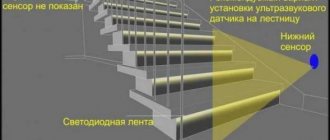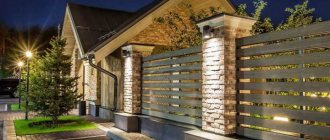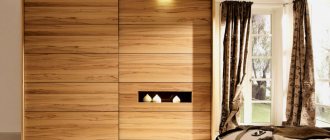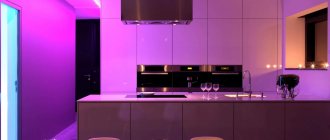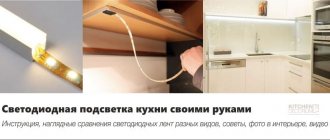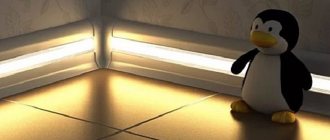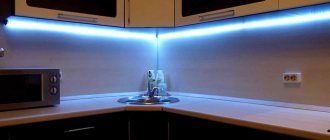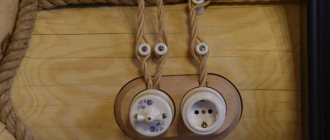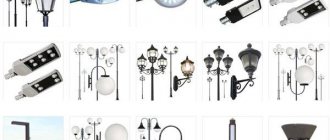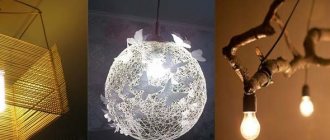The presence of two or more floors in a private house in itself indicates that it cannot do without stairs. Well, the stairs themselves in such conditions most often perform not only a functional role, but also are a decorative element of interior design.
Staircase lighting – which system is better to choose?
When designing and constructing such interfloor passages, many different nuances are taken into account. And the first thing that needs to be taken into account when starting such work is to ensure the maximum degree of operational safety of the structure being created. This concept can include such points as non-slip steps that are comfortable for climbing in height and width, an optimal slope angle for flights of stairs, comfortable and durable fences. And another safety parameter is effective staircase lighting. It is clear that the lighting of staircases inside a private house should also play a decorative role, that is, fit organically into the overall style of decoration of the premises.
Find out how to decorate the space under the stairs with your own hands from our new article on our portal.
Next, we will talk specifically about providing illumination for these interfloor transitions, which can be arranged in different ways, and using various lighting devices.
Recommendations for organizing lighting
When choosing the type of backlight, several features are taken into account:
- First of all, you should pay attention to the length of the descent. The longer the flight of stairs, the more light is required.
- The devices should emit a calm light that will not dazzle a person or irritate the eyes.
- Energy consumption should be economical since the backlight requires frequent use.
- You need to take care of safety and install an autonomous type of lighting that will operate using a battery or accumulator in the event of a power outage.
- The light flux should not create shadows or distort the configuration of the steps.
Beauty, safety, savings
Automatic lighting gives a very impressive appearance. In addition, the safety of movement increases. In addition to this there are other benefits:
- There is no need to feel for a switch on the wall in pitch darkness.
- Even if only slightly, energy is saved. Due to automation, the system is in an economical standby mode.
- Using automation tools when installing lighting, you can set up beautiful visual effects.
And you don’t have to worry that it’s expensive and inaccessible to an inexperienced user. The entire set of additional lighting is initially very inexpensive, and can easily bring additional comfort and benefit to residents.
What kind of lighting can I use?
The main lighting options are highlighted.
Automatic backlight
Thanks to this option, the operation of light sources is greatly simplified. Smart lighting with motion, load or switching sensors due to voice command and clap, can have one mode with the same intensity or smoothly operate on a timer with a certain time delay.
In the dark, the sensors react automatically and each step is illuminated sequentially. By setting up the control controller, you can set any parameters, for example, set the glow to the desired brightness level, and also select the speed at which the backlight will light up and fade out. Night lighting of the stairs should not be very dynamic.
The photo shows automatic lighting of the staircase in the interior of a private house in a modern style.
Wireless lighting system
A profitable option that operates on autonomous power. Such a system includes motion sensors and lamps tuned to the desired frequency. The operation of the composite modules is carried out using conventional batteries.
The photo shows a flight of stairs with railings equipped with wireless lighting.
Standard Wired System
Installing a traditional wired system requires some skill, so it's best to seek professional help.
First of all, a competent wiring diagram is required, then all the elements of the circuit are purchased and the surfaces are prepared to lay the cable. An ordinary concrete surface can be grooved, and in timber or log houses the wires are laid in cable channels and special corrugated tubes.
Automatic equipment
Some people choose an automatic lighting system. Not everyone is comfortable constantly using the switch when it is necessary to go down or up the stairs in the dark. With the help of lighting automation, it will be possible to facilitate the operation of the stairs.
When creating such conditions, various additional electrical installation equipment is used:
- Timer. The device is programmed for a certain operating time of the lamps. For example, if the house uses energy-efficient diodes as strips or light bulbs in spot products, then they are set up for the entire evening.
- Motion Sensor. Such a system reacts to passing people. The sensor is adjusted so that a moving person falls into the coverage area a few steps before the steps. When he leaves the area, then the light will go out. The operating time of the device can be adjusted independently.
- Load sensor. In the settings of this device, the required pressure indicator is indicated. When a person steps on the step, then the backlight turns on. The sensor can be installed either at the beginning of the stairs or several meters from the structure.
All these elements are connected to the lighting according to the usual circuit, which is given in the instructions for the product. It is recommended to install an automatic system in houses where children live.
Options for lighting fixtures for stairs
Popular types of lighting fixtures.
Spot lighting for stairs
The devices are mainly built into the wall, near which there is a passage to the second floor. The installation of such light bulbs is planned even before finishing the wall surface.
Spot lighting of steps or risers is considered convenient. To install floor lighting, purchase spotlights and attach them to the surface of the steps using self-tapping screws or a self-adhesive base. The main advantage of this type of lamps is the ability to change the direction of the light flow.
The photo shows a staircase in a private house, decorated with wall spotlights.
LED Strip Light
It features an adhesive base, which significantly speeds up and facilitates the installation process. LED strip can have a variety of colors. The most common is white light of a warm or cool shade.
Due to the flexibility and free variation of the length of the LED strip, there is wide scope for the implementation of original ideas. This type of lighting is installed under steps, under stair railings, or built into a box on the wall.
The photo shows blue LED lighting for a staircase in the interior of a country house.
Chandelier over the stairs
The lamp, harmoniously combined with all interior details and wall cladding, will favorably emphasize the surrounding design.
When using this type of lighting, the cable for connecting the lamp is hidden in the ceiling. A hanging chandelier can create high-quality lighting even for a two-flight flight of stairs. Very often, in spacious houses, a cascading chandelier is installed. Bulbs suspended at different levels provide even light for the entire lifting structure.
The photo shows a country house with a luxurious chandelier located above the stairs.
Wall sconces
Staircase lighting in the form of wall sconces illuminates a fairly large area. If it is not possible to groove the walls for wires, the plane is equipped with a cable channel.
Sconces can be combined into one electrical chain and a common switch can be installed. If a motion sensor is connected, it will be possible to automatically turn on the wall lamps.
The photo shows the interior of the hall with a staircase complemented by wall sconces.
Combined lighting
The use of several light sources is an excellent option for a flight of stairs to the second floor. For example, to organize only the illumination of steps, they can be equipped with spotlights or linear lamps. Sconces are used to illuminate the entire space. Lighting devices can be switched on either together or separately.
The photo shows the lighting of the staircase with a ceiling chandelier and wall spotlights.
LED Strip Light
This lighting option is now actively used in a wide variety of interiors. It is well suited for small rooms, narrow stairs, rooms with low ceilings. An LED strip does not require as much space as a sconce, chandelier or floor lamp, but it provides no less light.
The tape is sold by the meter, so before going to the store, decide where and how it will be placed. It is very easy to install - many types have an adhesive backing.
To achieve uniform illumination of the corridor, the tape can be placed in several places. It is usually glued under steps and handrails. If there is no sconce on the walls, a structure is attached to it, which is also glued. If there are niches or paintings, they can also be additionally illuminated. The tape is very flexible, so it is actively used in the design of various interiors. The drawings on the walls lined with LED tubes look unusual. Install a motion sensor, then the light will turn on automatically.
Which lighting arrangement is best?
Examples of placement of light sources.
Staircase lighting on steps
The lighting of the steps is selected to match the style of the staircase and the interior design of the cottage. For such lighting, it is better to prefer devices that have a soft glow that will not strain the eyes and form bright shadows.
To install lighting, holes are made in the steps and wiring is routed out. Light bulbs are placed in different ways in each stage or through one.
The photo shows a flight of stairs with LED illumination of the steps.
Lighting with wall lights
It is advisable to place the sources at the level of a standard human height and not too far from each other. This way you can achieve even lighting on the stairs and avoid darkening the steps.
In color and design, lighting fixtures should be in harmony with the style of the staircase and the overall interior of the house.
The photo shows a wall with spotlights in the design of the staircase.
Ceiling lighting
Top lighting is considered if the ceiling plane is at least 3 meters high, since such an arrangement of lamps visually conceals the area.
For the ceiling, it is better to choose lamps that have several spotlights with a diffuse, versatile light flux. Devices that create reflected or downward light will fit well into the staircase space.
Decorative lighting for railings
Thanks to the illumination of the railing, it will be possible to give the fence a shine and visually make it lighter. For decoration, they prefer LED strip, which adds exquisite charm and even some mystery to the staircase.
Kitchen
Not everyone decides to place a kitchen under the stairs. Indeed, in the process of arranging a working or dining area in such a place, you may encounter a number of problems. But it is quite possible to do this if you take into account many nuances at the stage of building a house and the general finishing of the entire room.
When arranging the space under the stairs, it is possible to place a kitchen there with almost any type of layout.
- A one-line kitchen will fit under a flight of stairs. Of course, it will be very small, and some of the upper cabinets will have to be abandoned, but this is a very convenient and space-efficient option, quite appropriate, for example, for a country house.
- An L-shaped kitchen is the most popular and most convenient option for arranging furniture.
- A U-shaped arrangement of elements is possible if, in addition to the space under the flight, there is also space under the second floor platform.
- G-shaped placement is an incredibly stylish and comfortable option with a bar counter.
- A kitchen with an island is a placement method that is possible if there is a free area of at least 20 m2. Very relevant for spacious rooms, especially if the kitchen under the stairs goes into the dining room.
Choosing lighting for the type of staircase
Depending on the material and design features, spans are divided into several types.
| Type | Better lighting | Photo |
| Spiral staircase | For a flight with steps that have a spiral arrangement, ceiling lights or devices mounted to a central post are suitable. | |
| Marching staircase | Such staircase structures are considered the most comfortable and convenient for installing any type of lighting. | |
| Material of steps and stairs | ||
| Wooden staircase | Wooden construction is highly flammable, so it is important that the electrical wiring is insulated. The span should be supplemented with low-current systems and lamps with bulbs that do not heat up. | |
| Metal staircase | Since this material conducts electricity well, all cabling is equipped with flexible insulation. This staircase looks original in the design of outdoor lamps in the form of a chandelier or sconce. When choosing lighting for a combined structure with plastic elements, you also need to take into account their flammability. | |
| Staircase with transparent steps | Acrylic or glass are used to make transparent steps. As a backlight, the end side of the steps is equipped with a screen that allows you to achieve a glowing effect. | |
| Concrete staircase | The best option for a concrete flight of stairs is side lighting installed fifty centimeters above the plane of the steps. If the structure is of sufficient height, a ceiling chandelier is installed. | |
Ceiling chandelier
Do you have high ceilings at home? The right interior solution would be to choose a chandelier for the staircase in the house. If there are many steps, a cascading lamp will do. Note that today this is not the most popular lighting option. But if it seems most suitable to you, choose a chandelier that will match the style of the rest of the interior. For example, if you have a classic design and a wrought iron staircase, then the lamps can also be wrought iron. For a loft-style room, a wooden lamp with metal elements is suitable.
If the chandelier will be the only lighting fixture, choose a large one with bright lamps. It is desirable that it illuminates every corner. There should be switches at the bottom and at the top - their location is thought out at the early stages of repair.
Features of choosing lamps for illumination
Lamps have their own characteristics and characteristics. The use of neon, halogen and LED bulbs is a traditional solution.
Neon products have a soft, diffused glow that fits perfectly into the limited staircase space. This type of lamp is durable, but at the same time sensitive to mechanical stress. Therefore, a reliable protective housing should be provided for them.
Halogen has a brighter luminous flux, which leads to strong heating. Therefore, these models are not recommended for use on wooden marches.
LED lamps are characterized by different shapes, colors and power levels. LEDs provide economical energy consumption, have a long service life and do not heat up.
Sensors
We install one motion sensor at the beginning and end of a flight of stairs.
We recommend that you learn more about how to adjust the motion sensor if you are using a non-programmable version of the device.
Our infrared motion sensors for turning on the lights on the stairs are quite functional, but the installed caps narrow the viewing angle. Therefore, we get rid of the caps and leave the sensor itself. In order for it to turn on when approaching the steps, it is advisable to even deepen it a little during installation in order to further narrow the viewing angle. Thus, it will react to movement precisely when approaching and leaving the steps.
Another light sensor wouldn't hurt. Thus, we get automatic control of the brightness of the backlight so that it does not blind the eyes after dark.
The final system diagram looks like this:
Preparing the controller
What is a controller with Arduino based driver chips? This is a microcontroller with many ready-made settings and hardware modules.
In order for it to work in the desired mode, it needs to be programmed. Suitable firmware with download instructions are freely available on the Internet. Below is also a sketch of the program, you can download the sketch here: https://cloud.mail.ru/public/5GtW/5M5CvRwLc
We take our Adruino scarf and connect it to a computer or laptop. Go to the Arduino IDE and click on the “Download” button.
Once the selected firmware is downloaded to the board, we can begin the final assembly of our entire backlight circuit.
How to make step lighting with your own hands?
The stage lighting device requires two power supplies. The first is used to maintain the correct voltage balance, and the second is used to integrate the circuit into a household network.
Step-by-step instruction
In the attached instructions, all stages of connecting the staircase lighting are described sequentially. Therefore, any beginner can handle the installation.
For self-assembly, you will need to use tools in the form of a tape profile, self-tapping screws and a screwdriver. If there are protrusions at the steps, the LED tube is attached using an adhesive backing. Otherwise, you will need to use an installation profile.
- Cut the tape to the desired width.
- Mount the profile on the steps using 4 self-tapping screws.
- Attach the open LED strip to the profile.
- Close the tape with a special insert, which acts as a protection and anti-slip element.
- Conceal the wires under the baseboard or steps.
- Connect the power supply, stabilizing and control device.
- Close the circuit to the switch.
Video tutorial
A visual example of the installation of staircase lighting.
Pantry
The space under the stairs can be successfully used to create a storage room. Various household items, household items, and canned foods will be conveniently located here. On special fasteners you can place a vacuum cleaner, ironing board, mop, children's ice sled and even a small bicycle or scooter. The pantry can be open or closed with a door.
Open structures are appropriate if they do not spoil the appearance of the room into which the stairs descend; these could be utility rooms or a non-front part of a corridor or hallway.
Closed storage rooms under the stairs can be located in the living room or hallway. Sometimes, as part of the overall interior design, doors are decorated.
Beautiful design ideas
The multi-colored LED lighting of the staircase will give a new look to the surrounding space. This design technique will create a unique and inimitable atmosphere in the interior of the house.
The photo shows the design of a staircase with multi-colored lighting in the interior of the house.
An unusual solution is to decorate the steps of the stairs with garland, lanterns or candles, which can be lit only when necessary.
Children's room
Everyone remembers Harry's famous little room in the closet under the stairs. Modern parents, of course, will not give their children a place in the closet, but setting up a play area in the under-staircase space is a very good idea. A wide variety of options are possible - from simple ones with carpeting and children's toys placed there, to fairy-tale houses that are unique and amazing in their beauty and believability in their details. Such a magical structure will give the child a lot of ideas for games and will develop fantasy and imagination. However, do not forget that the location of the steps of the stairs next to the play space creates the need to provide for the protection of the child. Installing child safety gates is a must.
Automation and basic rules
Lighting automation, which is part of the general understanding of the system called “smart home,” is gaining more and more supporters. The use of touch sensors eliminates the use of light switches in the usual sense. Staircase lighting relays, working on the principle of responding to movement or pressure changes, automatically turn the lighting system on and off.
Lighting rules:
- Built-in wall lights should not emit excessively bright light, causing blinding and making movement difficult.
- You can increase the brightness of dim lamps by placing them as far along the length of each tread as possible.
- More powerful lighting fixtures are used for stairs located away from sources of natural light or structures made of dark materials.
Description
All elements of the lighting system operate autonomously. Each device contains 3 batteries.
More extensive information on the operation of autonomous backlight can be obtained either from the product data sheet, or you can find the desired model on the Internet.
But in any case, such a system will not require much effort for installation, and the stairs will no longer be a source of increased danger.
